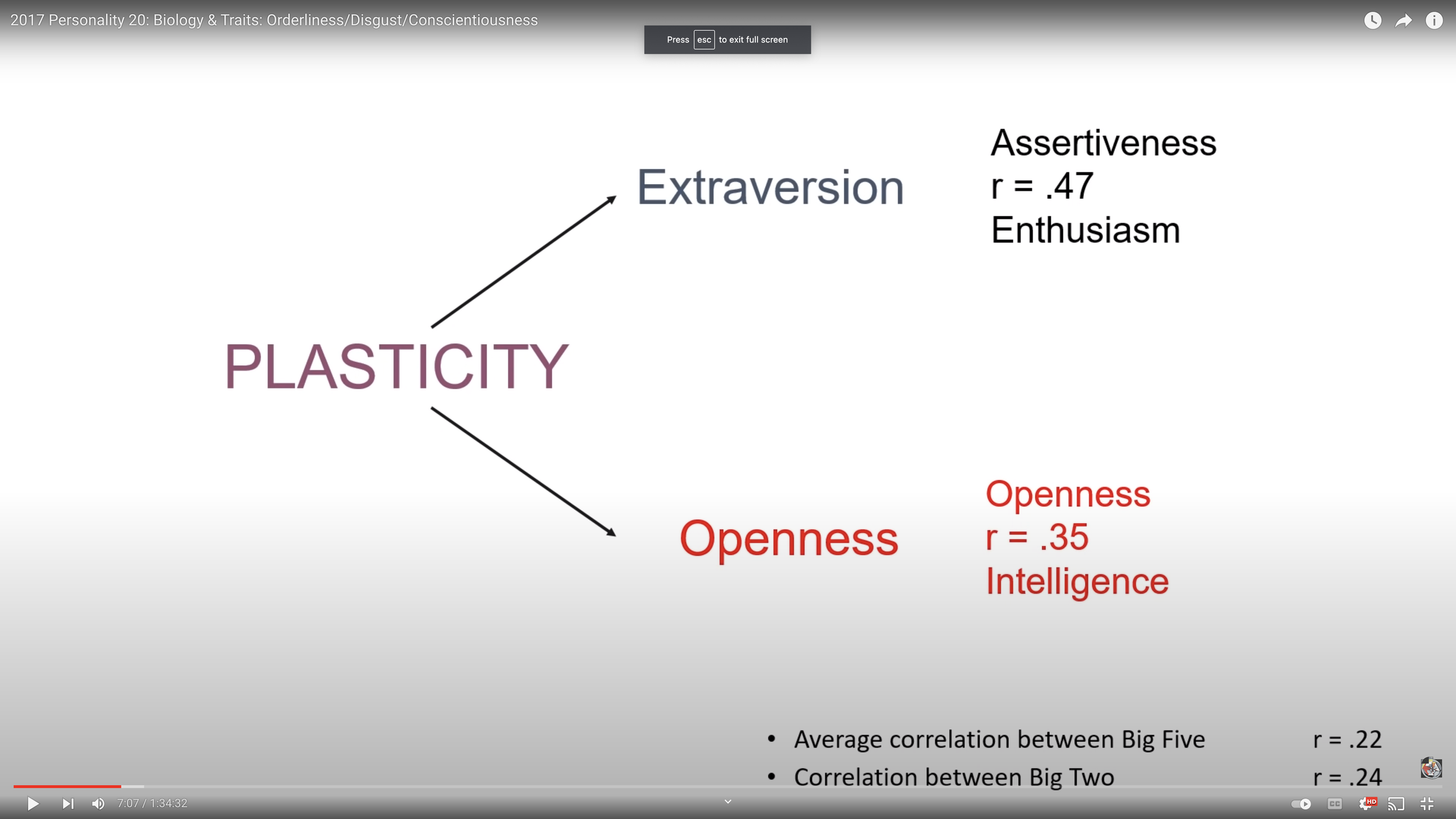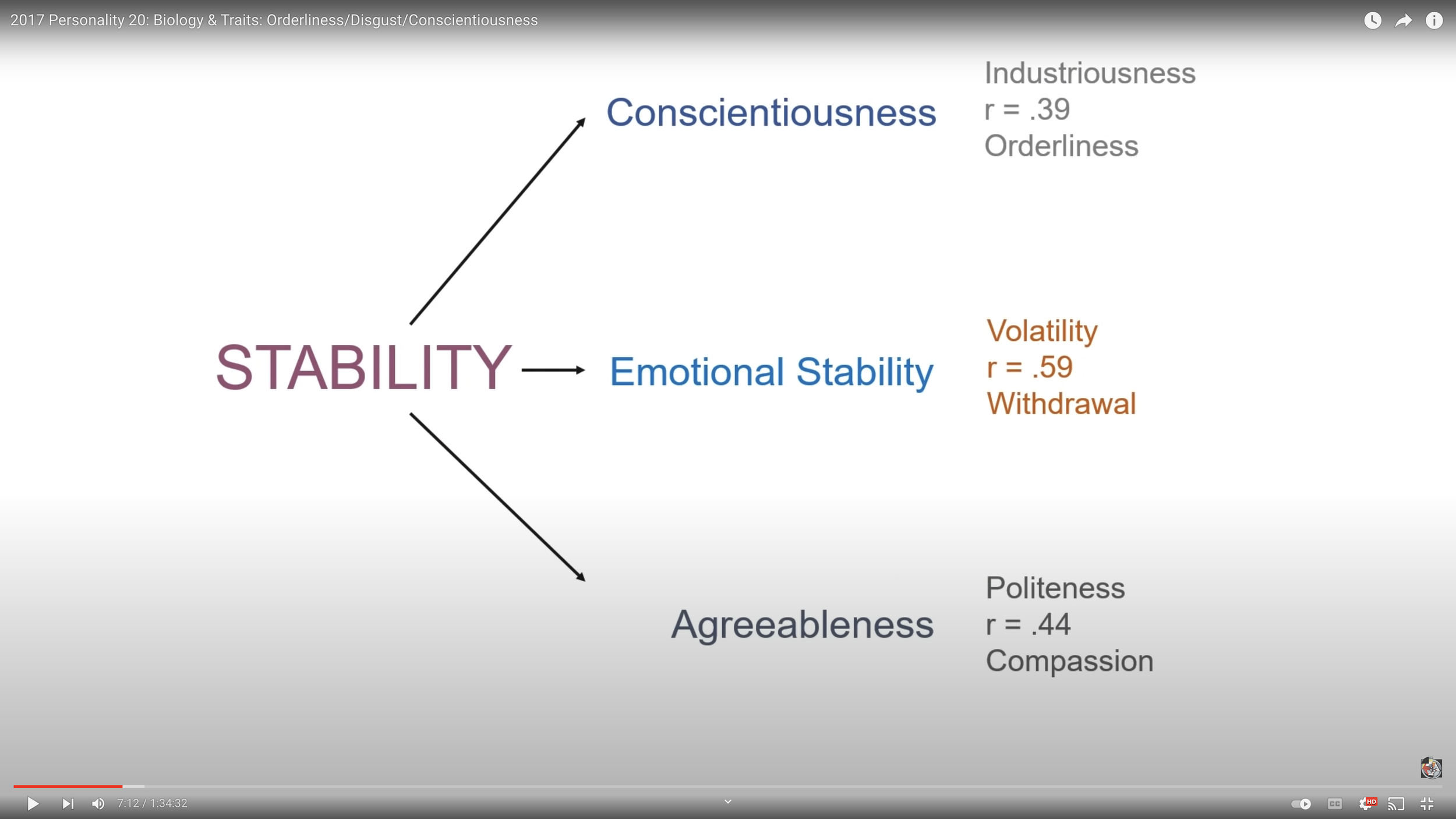Miles's Personality in 10 Facets of the Big Five
At understandmyself.com, Jordan Peterson offers a personality test for $10 based on an expansion of the Big Five personality dimensions into 10 aspects. The “Big Five” emerge from factor analysis of words in the language used to describe personality differences. To remember the Big Five, use either the acronym OCEAN or CANOE: Conscientiousness, Agreeableness, Neuroticism, Openness to Experience, Extraversion. The 10 aspects split each of this into two:
Conscientiousness is about Industriousness and Orderliness
Agreeableness is about Politeness and Compassion
Neuroticism is about Withdrawal and Volatility
Openness to Experience is about Intellect and “Openness” proper
Extraversion is about Assertiveness and Enthusiasm
Because factor analysis is maximizing how much can be accounted for by a given number of factors, the Big Five, or their expansion into 10 aspects, these factors account for a large share of the variance in personality. There isn’t that much left in personality differences between people that is not captured by the Big Five or these 10 aspects. Many interesting interpersonal differences with other labels can be reexpressed quite well as linear combinations of the Big Five or the 10 aspects from the Big Five. For example, being high on the two aspects of Openness to Experience and low on Orderliness is highly predictive of leaning left, politically; conversely, being high in Orderliness and low on Openness to Experience is predictive of leaning right, politically.
IQ is a different matter; it is not counted as personality, though it is often extremely valuable in predicting things that personality is also predictive of. For example, income is well predicted if you know IQ and Diligence. (The personality aspect of Intellect has to be carefully distinguished from IQ. Intellect is about being interested in abstractions. Some very smart people are interested mainly in concrete things; some people of average intelligence are fascinated by abstractions.) Intellectual abilities factor analyze with a very strong first factor. That means people good at one type of problem solving have a strong tendency to be good at each other type of problem solving. Howard Gardner made so much hay with his book Frames of Mind: The Theory of Multiple Intelligence because it takes a high IQ and great diligence to make a story that is so misleading in relation to the facts sound like it is on a solid footing. Of course, the first factor for intelligence does not exhaust the variance. But it is misleading not to lead with the fact that almost any two measures of intelligence have a high positive correlation. (That is, a high positive correlation in the population as a whole. Highly selective universities that choose all people with uniformly high intelligence in terms of the first factor of intelligence then have the remaining variance mainly from the smaller second and higher factors such as verbal vs. mathematical.)
As an economist, I am attracted to Principal Components Analysis, which fairly transparently reexpresses the variance-covariance matrix for a set of variables in terms of eigenvectors and their associated eigenvalues. In Principal Components Analysis, the different components (=factors) are uncorrelated by construction. But psychologists typical use factor analysis with rotation to get factors they consider easier to interpret. And these factors can have some correlation. In the case of the big 5, those correlations are on average .22. The two aspects within each of the Big 5 are reasonably distinct, with correlations within each pair between .35 and .59, as follows:
These are slides from one of the lectures up on YouTube for Jordan Peterson’s Personality class. They also illustrate that the Big Five can be divided into two groups: Plasticity and Stability. Note that “Emotional Stability” is simply Neuroticism times -1.
I should note that some of the other statements I make in this post are also drawn from having watched Jordan Peterson’s Personality class (as well as others of his classes) on YouTube.
Agreeableness: 11
Compassion 42
Politeness 2
Conscientiousness: 63
Industriousness: 97
Orderliness: 7
Extraversion: 86
Enthusiasm: 79
Assertiveness: 85
Neuroticism: 14
Withdrawal: 6
Volatility: 34
Openness to Experience: 95
Intellect: 96
Openness: 84
The full report on me is here.
So I don’t sound too bad, let me quote this in the report about “Politeness”:
People who are exceptionally low in politeness challenge and confront authority – and they are not obedient. If they are respectful, it is grudgingly, and will only be manifested toward people who continually both deserve and demand it. They are comfortable confronting other people, and enjoy it. People extremely low in politeness are motivated to engage in conflict, and to seek out confrontation.
Note how different I am on the two aspects of agreeableness. I am also very different on the two aspects of conscientiousness: high on Industriousness, but low on Orderliness. In the description associated with being low in orderliness, I resonate to these two bits:
“… non-judgmental and devil-may-care in their attitudes toward themselves and others.”
“dislike schedules, list, or routines”
However, I like routines reasonably well if I made them up myself.
The aspects of the Big Five can help predict other outcomes of interest:
High IQ and Industriousness are good predictors of income. The other 9 aspects not so much. (Openness to Experience is positive correlated with creativity, but I’ll bet creativity is more closely related to the variance of income than to the mean of income.)
High Openness to Experience and Low Orderliness are good predictors of being politically Liberal.
High Agreeableness and High Orderliness are good predictors of insisting on political correctness. Conversely, Low Agreeableness and Low Orderliness (my bent) would predict a low level of political correctness.
Finally, being low on Withdrawal sounds like it is good for happiness. And indeed, I am generally quite happy. Here is some of what my report says about being very low on Withdrawal:
Individuals very low in withdrawal almost never suffer from or are impeded by anticipatory anxiety. They can handle new, uncertain, unexpected, threatening or complex situations very well. They are far less likely to avoid or withdraw in the face of the unknown and unexpected.
People with very low levels of withdrawal feel sad, lonesome, disappointed and grief-stricken very infrequently—and, if they do, do not feel those emotions deeply nor for long. Their lives tend to be markedly free of doubt, worry, embarrassment, self-consciousness and discouragement, even in the face of genuine threat and punishment. They are resistant to and rarely worried about social rejection, and almost never feel hurt or threatened.
Overall, I feel very lucky to have the disposition I have. People sometime act as if I am an alien, because I am extreme in some aspects of my personality. But I feel I have had a very enjoyable life.
To sum up, I am a hardworking, freewheeling, enthusiastic, assertive, happy, stable, convention-breaking artist-intellectual who cares about people.


